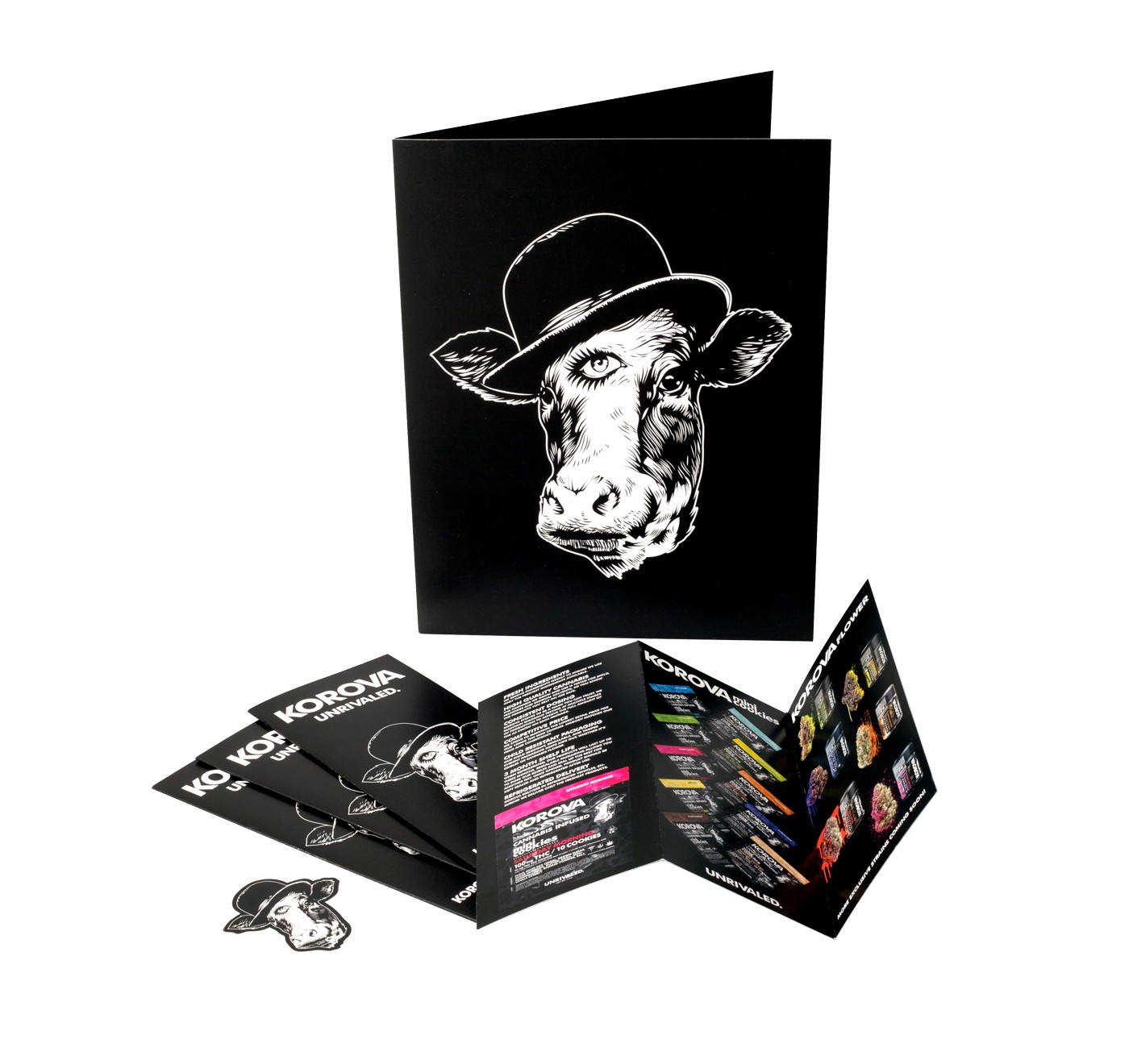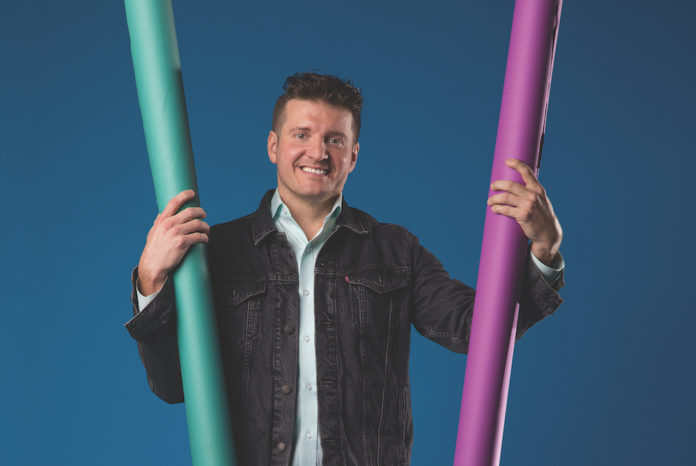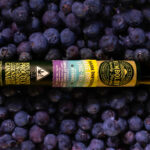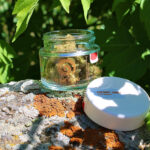Without access to a time machine, it’s impossible to go back and tell your younger self a fiery love for skateboarding, performing music, and smoking weed can lead to a successful career generating tens of millions in annual revenue.
But that’s exactly what set Dameon Guess on the path to his Jakprints empire.
To be honest, the business didn’t appear out of a cloud of smoke with punk rock blaring in the background, although Guess may want to consider that route for the biopic. Creating the printing-and-packaging giant took an innate ability to sniff out an underserved market and decades of learning on the fly to shape the entrepreneurial marvel.
Guess grew up in small-town Kirtland, Ohio, home of the first Mormon temple. The area wasn’t exactly a major hub for counterculture, but that didn’t stop the intrepid Guess, who outsourced that part of his education to the likes of Cypress Hill. “I was a music, art, and skateboarding kid, so I grew up reading Juxtapoz magazine and buying records,” he said.
Though he hasn’t moved far from where he grew up, Guess operates in a whole different world now.
Jakprints pulled in more than $25 million in sales in 2017, printing stickers, flyers, banners, T-shirts, and almost anything else customers dreamed up. The company serves more than 60,000 clients ranging in size from a SoundCloud rapper funding recording sessions by selling merchandise to AT&T.
The deeper Guess became immersed in skater and music culture, the more he gravitated toward the imagery of it all, teaching himself how to create art by trial and error.
“As my passion grew for those things, I found myself drawn to graphic design,” he said. “At the same time I was playing in a band, and as an independent musician you need a lot of printed promotional materials. From flyers to spread the word about a tour to the merch we’d have to sell to make enough gas money to get to the next stop, it was a constant need.”
What started as a hobby began to consume more and more of Guess’s time, but the early grind would pay off a hundred-fold in an industry that weeds out the imitators and champions vision and originality.
“This was around 1998 or ’99, and as my band’s graphic designer I was always scrambling to figure out how to get things made,” he said. “It wasn’t like today with the internet where you can just hop onto a site like Jakprints, upload a graphic, and get all your shirts, stickers, and posters done in the blink of an eye. I kept finding myself sourcing all my different products through completely different channels; getting my stickers one place and having to call another place to get my T-shirts printed. It was quite a learning curve. Many places back then didn’t even accept digital files. So, as my band continued to grow, I ended up learning a ton about the printing business and the entire process of turning an idea into a tangible product.”
Guess kept accumulating knowledge, and when his band split up, he opened his own graphic design firm. He already had a built-in client base of bands, because who knows the promotional needs of a traveling musician more than one of their own?
“We’d always be playing with three or four other bands every night,” Guess said. “Eventually,
I became somewhat of a broker, creating designs for these bands and finding the printing solutions to get the job done in time.”

What are the biggest changes you’ve seen in the printing business over the PAST TWENTY years?
The limitless potential of Photoshop and Illustrator and all these other applications really empowered the next generation of creatives, to the point where you really didn’t have to go to some expensive school for graphic design. I dropped out of high school and only made it through two weeks of art school because I had advanced past my professors while teaching myself. Anyone and everyone with some kind of computer or tablet can use those powerful tools to create things. In this digital revolution, someone can make their own movie, start their own clothing company, or take their band way farther than ever imagined, all using new technology that empowers creators.
The technology bridges the creative process and entrepreneurial spirit, allowing for more small, independent businesses to take off without a high cost of entry.
It’s never existed before. My dad would tell me that in the ’60s they never could have dreamed of this. They didn’t want to sit at a desk or in a factory for forty or fifty years, but there just wasn’t as much opportunity to travel and work remotely as there is now with the internet. We can plug in our laptop at home or a coffee shop and virtually be at the office.
Has Jakprints always produced packaging solutions for clients, or did that start when you began working with cannabis brands?
We’ve always been doing packaging or folding cartons and point-of-purchase displays, everything you can imagine from lipstick to food to retail goods. Those projects have always been in our wheelhouse.
What had to change in your creative or production process to work with a cannabis brand?
Now, because of the regulations surrounding child-proof packaging, there are far more involved discussions as far as what the packaging will have to look like or what it will have to fit inside that meets the stipulations. And that varies from state to state. So, that has been a new challenge for us, but the beauty of what we’re doing is that we can learn and then use that going forward in this and all industries. We don’t have to change a ton; it more changes the dialogue with our clients.
What we’re seeing now is many of these brands and companies have their own in-house creative and design teams. But when we are part of the discussions with these brands that are trying to differentiate themselves in the marketplace, we love engaging in the development of new ideas around product design. What is this going to look and feel like at point of sale? Where is it being sold? What kind of packaging will best highlight and showcase this product to consumers? What will the experience of unpacking this product be? Creating that experience is where I get to weigh in sometimes.
One would think increased regulation would hinder creativity, but with cannabis, regulation seems to be forcing innovation in marketing and manufacturing.
The innovation has been amazing. It’s incredible the amount of creative people I see leave traditional roles in entertainment or other sectors for the marijuana industry. Cannabis companies recognize and need these skill sets. Legalization has definitely not stunted anyone’s growth or creativity. It’s given way to a ton of really interesting innovation.
As cannabis continues to move into the mainstream, what role do marketing and branding play in destigmatizing and normalizing weed culture?
The packaging and marketability of cannabis allows for the creation of top-shelf, consumer, and economy brands. From a sales standpoint on our end, there’s all these different things you can do, like embossed packaging and silver foiling, that really create that end user experience like opening an iPhone box. Marketing and the ability to communicate a product like cannabis is the first step in trying to legitimize it. The packaging acts as the first impression a consumer has of a company and allows a brand to educate the customer while introducing a product as opposed to just issuing out plastic bags or nondescript pop-tops. For example, the flower in the nitrogen-sealed tins creates such a powerful experience for the customer that gets to open it. Ideas like that help frame the product as more than weed. And we’re in the earliest stages of the marijuana marketing boom. The sky’s the limit, and there is so much growth still to realize in branding and creativity.

How has cannabis branding changed in the past few years? Are companies moving away from kitschy green 420 stoner branding toward more polished approaches?
For sure. The trends are mirroring what we’re seeing in pop culture, where great focus is put on fonts and color schemes. The brands, packaging, and logos are almost interchangeable, where you’re looking at a product and saying, “Is that a technology company or a weed company?” These cannabis companies that couldn’t even give us a JPEG of their logo a few years ago now have in-house designers and creative directors shaping the visual aspects of their brand.
How does growth in the cannabis industry compare to OTHER SECTORS?
This is by far the most exciting industry to work for, because there doesn’t seem to be many boundaries right now. The potential is limitless, and the creators are letting their imagination run wild. When you have someone sit down with you who has a reasonable budget and a lot of good ideas about their branding from a visual or physical engagement standpoint, you can’t ask for a better client. You can feel the urgency when working with these brands.
Even though people may think “oh they’re just stoners,” these creators are all about hitting the mark and succeeding in this space. They’re building sales teams, they’re going to trade shows, they’re doing pop-up customer appreciation events. It just seems very motivated and functional.
Cannabis is a fresh, new industry, and we’re just starting to see the potential of what it can do. Everyone is motivated by wanting to get it right, and we try to lead with quality and consciousness. You want to work with purpose, and that’s what we’re seeing: a lot of companies working passionately to accomplish something great. A lot of the other industries we work with, people are just working a job.
The cannabis industry is homegrown, and you can feel the innovation and passion immediately. When you love what you do, it shines through. And we love what we do. I couldn’t imagine working in a better time in this movement as cannabis comes out of prohibition.
Have you faced any challenges in the traditional world as a result of your cannabis-related business?
About four or five years ago there was a real concern. We were worried about how we’d get paid by [cannabis] clients, as in would we be able to accept funds that were generated by a product that’s technically illegal? We didn’t normally get paid in pillowcases full of cash, for example.
We just tried to be selective about who we worked with, choosing upper-echelon brands that we felt represented where the industry was going in the future. We did a lot of boxes for Bhang Chocolates in the beginning. We were never touching actual product, just consulting about design and marketing around the branding. Our play was somewhat easy in that sense, and we knew our risk was minimal because our other clients in the music, video game, and skateboarding industries, for example, wouldn’t care that we supported the weed movement.
Where we do run into a little bit of overlap is we work with some nonprofit institutions that rely on grants and government support, as well as schools and churches. So, we’re careful not to market the same services to both groups or keep the weed products in their faces. We keep our marketing materials different for whichever client base we’re targeting. We serve big brands like AT&T and Fanatics, and sometimes people are surprised we’re able to work with mainstream companies like that and ones in the cannabis space, so we’re trying to merge them a little more. We know that early adopters sometimes catch a little flak, but we want to be on the forefront.
It’s great we’re able to engage in this business without having to create some sort of shell corporation, because we still deal with plenty of vendors who refuse to work on cannabis-related projects. They’ll reference religious beliefs or their political views, and they will not work with us on a project. This is an industry that’s emerging, not going anywhere, and it’s only going to get bigger, so there will be lots of work and we’re happy to do it.
How has environmental awareness affected the printing business, and how will it influence shifting trends going forward?
I wish I could say [environmentally friendly practices are] going great industry-wide or at least getting better, but it’s been a little bit of a smoke-and-mirrors kind of thing, honestly. I found far more alternatively sourced and recycled materials being used when I first got into this business than there are available now. A lot of the sustainable options I found when I was starting out twenty years ago—like hemp, kenaf, and cotton-based papers—are more rare than ever, and I don’t know why that is besides consolidation in the industry. There used to be dozens of large paper companies, and now there are about five. They seem to be making less and less paper, which means they’re also making it increasingly difficult to get 100-percent or even 50-percent recycled materials.
Consumers and the buying public have to be more influential in the decision about what we make things with and what kind of paper we’re using. We want our paper and our consumables to be more responsibly sourced, or else we’re just getting what they’re selling us. At this point, I cannot buy kenaf paper or hemp paper anymore at a price point that even affords me the opportunity to be competitive. Furthermore, there’s so much paper coming into the country with no chain of custody or accountability for environmental impact—a lot of operations around Asia are just clear-cutting whole forests. People buy it because it’s cheaper, but it has no recycled content in it at all.
I’ve seen it change for the better in terms of digital allowing us to use a lot less waste on the production front. We’re not doing film or using cameras. We’re writing our digital files directly to recycled aluminum plates. We recycle everything, and we do the best we can with the machines that we purchase to cut down on the amount of pre-consumer waste. There’s still a long way to go, though, and it has to come from us, the consumers, saying “this is what we want.” But it’s regressed from twenty years ago, for sure.

Is that why you plant a tree for every order, to balance deforestation caused by the paper industry?
Bingo! Because my company is still independent,
I can drive it according to my personal sensibilities and make gut decisions about things like environmental impact. If I’m going to take trees and take cotton and take these other things we use, I want us to replenish those resources and give back as an organization. That’s the approach that feels holistic and intelligent to me. You take, you replace. We’ve planted 350,000 trees in just over four years. That program will forever be a part of our company’s ethos.
Locally, we work with the Arbor Foundation in Cleveland and the Cuyahoga National Forest, which is the only national forest we have east of the Mississippi River and about thirty minutes from us. Cuyahoga is one of my great clients, and we’ll go down there with our employees to plant trees. We also work with a partner company called Trees for the Future, which carries out the majority of our tree-planting initiative, restoring forests in Central and South America and other areas that have been decimated. Through them, we create jobs in the areas hurt most by deforestation, which improves the symbiotic relationship people have with their local ecosystem. By replanting the trees we grow and subsequently cut down to use for printing materials, we help maintain a renewable resource.
Though teenage Guess might be disappointed to hear he didn’t become a rock star in the traditional sense, the adult can rest assured he’s attained legendary status nonetheless, reaching millions with his work and making a positive impact with the platform he’s built—all while sparking up whenever he wants.
“I’ve consumed cannabis since I was fourteen years old,” he said. “It’s unlocked all kinds of creativity within me. It made my music sound amazing, and it ultimately made me a better citizen of the planet Earth, man.
“This is a really powerful medicine,” he continued. “Almost thirty years later, I still smoke herb every day, if not a couple of times per day. I’m proud to break down those stigmas of a ‘pothead.’ I have more energy and get more accomplished than plenty of my straight-and-narrow counterparts. The younger version of me couldn’t even comprehend how far we’ve come as a country in embracing this plant. Industrially, medicinally, spiritually, it is a profound resource. I love it.”
Dameon’s 3 Marketing Tips for New Cannabis Entrepreneurs
1) Really know your customers and try to understand who they are, why they do business with you, and what you can do to retain their business.
2) Know your competition and how your product or service differs from theirs. Identify and communicate what makes you unique or better.
3) Establish a memorable brand. A strong logo, icon, tagline, and consistent colors are essential for all businesses. Clean and simple often stand out and can create instant recognition among consumers.












